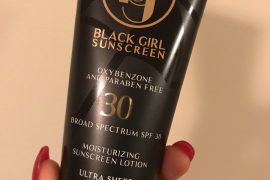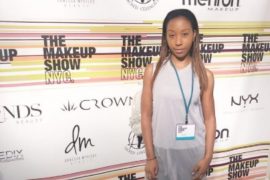Starting today, Target will add eight up-and-coming cosmetics brands created for medium to dark tones — mostly designed by women of color — to its e-commerce site. Plans call to roll those lines out to hundreds of physical stores on May 20. The bold introductions will be front and center on end of aisle displays in beauty with graphics broadcasting the wide hue options
Target is no stranger to serving multicultural shoppers. The chain was a pioneer in the textured hair category more than a decade ago. Demographics suggest Target is on the right route. According to the U.S. Census, Hispanics or Latinos now comprise 18 percent of the population; African-Americans 13.3 percent, and Asians close to 6 percent. Almost 3 percent of Americans check off they are two or more races, and one in 10 have a spouse of a different nationality or ethnic background.
“The world is changing, especially for the Millennials and Gen Z,” explained Christina Hennington, senior vice president merchandising for essentials, beauty, pets and wellness at Target. She said these more multicultural generations have high expectations including an array of shades. “We carry breadth [of assortment] and that’s paid off in hair care and we are confident it will in cosmetics, too.”
Target, she said, has more than 100 brands designed to meet diverse shopper beauty needs. The 150 new products are culled from up-and-coming online brands that have caught Target’s eye. “This is an evolution of a strategy that has been building 10-plus years at Target,” Hennington noted.
Target would not comment on sales, but industry sources estimated the fledgling brands produce in excess of $50 million collectively. The Target exposure can only ignite the sales fuse.
To help introduce the fledgling brands, Target will put muscle behind education and a strong in-store presence. Sales materials use the popular swatching methods made popular on social media to show the range. “We’re going to have to introduce some of the brands to our consumers,” Hennington confirmed. “In some cases, they’ll know them, in other cases they’ll be lots of guests discovering them for the first time. We can bring scale and new eyeballs.” Target has shown its mettle in helping digitally native lines make the jump to retail such as Harry’s shave. The new lines are also featured on Target’s New In Beauty page on its web site.
The eight lines are: Coloured Raine in 14 items; Every Hue Beauty with 19 products; Haley’s including 31 choices; Hue Noir consisting of 20 shades of foundation; Makeup Geek’s 27 options; a range of 17 items from Reina Rebelde; 29 lip shades from The Lip Bar; and 13 products from Violet Voss. Prices range from $9.99 to $24.99, a value against Fenty, which has average price tags in the $30 range.
Many of the newcomers were created out of a market gap. Former Wall Streeter Melissa Butler, for example, devised The Lip Bar when she couldn’t find a trendy, electric-hued lipstick to complement her skin tone. So, she made her own vegan, organic lipsticks six years ago.

A selection from Coloured Raine.
Target’s bold moves are in sync with shoppers’ wants, according to industry experts. “We’re seeing brands that are more inclusive getting big quickly. They are becoming the norm,” said Jordan Rost, vice president of consumer insights for Nielsen.
Furthermore, research from Euromonitor revealed that although historically legacy brands “have ruled the dynasty,” digitally-born lines have become the growth engines. The research firm explained that from 2008 to 2016, color-cosmetics challenger brands grew by 16 percent a year, four times as fast as legacy companies. The upstarts now account for 10 percent of the color-cosmetics market, up from 4 percent in 2008. Driving that are younger consumers who are said to be more likely than baby boomers to experiment with new brands.
Target handpicked its new entries by keeping an ear to the ground. “Our team, whether it is our guest insights, our merchants or marketing partners, is constantly looking for brands that are influential, or making a mark or are hitting a missing need. Our merchants are entrepreneurial in their pursuit and, of course, brands come to us and, in this case, it is a combination of both. It is a lot of boots on the ground,” she explained. Hennington said Target is committed to giving the fledgling brands the tools to succeed. “We will have compelling presentations to make sure our guests take note of something new,” she said confirming the items are permanent in the mix at least through 2018 in select doors.
Hennington elaborated on why Target doesn’t go full force in all stores at first. She noted the items are available online. “There are two reasons we don’t go into all stores. One is we want to make sure the brands are set up for success and in stores where guests are most likely to respond and the second it is important for us as we work with small entrepreneurial brands that we are cognizant of how to properly scale. These are brands that are investing a lot and we are helping them understand how to go from small to the scale that Target would offer.”
With the items getting off-shelf presentation, there is no current shifts in the brands Target has traditionally stocked. However, the industry’s legacy brands continue to face challenges as shoppers flock to innovative and new lines like those exposed on social media, private labels or with fast-to-market innovators like NYX and E.l.f., noted industry expert Allan Mottus.
Target has been sprucing up its beauty department with plans to update at least 350 doors within the year. The fresh decor features lower gondola profiles, more service including an area for sampling, enhanced lighting and hot spots for new trends. Banishing the bland atmosphere endemic to mass market beauty retailing characterized by rows and rows of pegged cosmetics, Target has created a department that invites product discovery.
“The challenge will be to see if the lines turn enough,” said Mottus. “If so it will debunk the old 80/20 rule where 80 percent of the sales came from just 20 percent of the items.”
source : wwd








